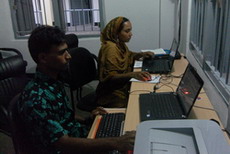হোম > Union Information Service Centers and Sustainability
লেখক পরিচিতি
লেখকের নাম:
আহমেদ হাফিজ খান
মোট লেখা:১৫
লেখা সম্পর্কিত
পাবলিশ:
২০১১ - জুলাই
তথ্যসূত্র:
কমপিউটার জগৎ
লেখার ধরণ:
সেবা শিল্প
তথ্যসূত্র:
ইংরেজি সেকশন
ভাষা:
বাংলা
স্বত্ত্ব:
কমপিউটার জগৎ
Union Information Service Centers and Sustainability
Almost since the very beginning of Union Information Service Centers (UISCs) or Community e-Centers or UISCs or public access centres the nagging from funders - mostly governments but major NGO's as well - has been directed towards making sure that these would somehow/sometime become financially self-sustaining i.e. ‘sustainable’. The idea was that once the initial investment had been made - mostly in providing hardware/software and some period of supported connectivity - that UISCs would somehow magically be able to transform themselves into ‘social enterprises’ which could get enough revenue from their local communities to:
1. Pay salaries (and benefits) to staff
2. Pay rent on buildings
3. Cover access charges
4. Cover charges for maintenance and replacement
Given that the UISCs were established in the first place and located where they were precisely because the local population was for the most part poor, isolated, and otherwise marginalized i.e. not in a position to pay for their own computers, Internet access etc. seems to have escaped the attention of those leading the demands for ‘sustainability’.

To be very clear:
certainly there are publicly accessible Internet centres in very many communities in all parts of the world. The most common name for them is Cybercafes. Cybercafes provide computer/Internet access primarily to young males and females to fulfill various fantasies via more or less violent games and other such pursuits. That it is widely headlined that these private enterprises have little or no redeeming social value and certainly no value from a social or economic development perspective let alone resolving issues of a Digital or contribute towards development of Digital Bangladesh is almost unarguable.
The broader purpose of UISCs was and remains to add value as social initiatives by governments or others by providing free or very low cost Internet access to low income populations, in remote regions, or for those with other forms of social disability that prevent broad participation in an increasingly digital society. If governments (or others) choose to de-fund existing UISCs on the basis that they are saving them from the evil of "dependency" (or whatever) they should know that they are choosing to penalize precisely those whom they have otherwise identified as requiring support because of their social and economic circumstances.

Governments are not only unrealistic but they are deeply hypocritical in requiring communities in which they previously made these investments because of their overall lack of resources, to somehow now come up with the resources to support these facilities. One additional observation, UISC funders repeatedly confuse the issue of UISC utilization rates with the issue of funding and sustainability.
These services (which of course, will vary from locations to location) are responsibilities and goals for which government funds have been budgeted. Attempting to download responsibility and cost for the delivery of these services onto the poor and marginalized themselves - which the continuing chants for "sustainability" in fact are, is both the height of irresponsibility and the height of cynicism.
The challenge is to design and develop UISCs which are embedded ("owned") by local communities and which provide those communities with among other capabilities the variety of services and supports (as for example e-government, e-health, small business development and support) which they require and which otherwise, in the absence of the UISC, would be much less accessible and much more costly and difficult to obtain (and to deliver).
The country is faced with numerous issues such as supply of quality electricity, provide quality education, providing health care to rural or marginalized community. All these issues need to be addressed concurrently to generate the demand for e-services. The cable TV in the country has flourished because the content has generated demand in the households. Any attempt to switch off the cable tv results in deep resentment within the society but unfortunately the UISC are unable to generate interest in the society specially rural communities because for the lack of any content attractive to the rural communities. The services provided by the UISC have been pushed through by the top rather than accessing the requirements of the grass root. The grass root beneficiaries are also unaware of the services available to them through these UISCs. Again looking at the purchase power of the marginalized rural community the pricing and subsidy mechanism also needs to be ascertained before embarking on setting up UISCs.
Scenario at UISCs
1. Nevertheless, the 4500 UISCs have already been rolled out. Now the time is to rethink about the strategy and learn from our past short comings before it is too late. The recent visit to some of the UISCs at different location indicates empty UISCs or non-functional UISCs. In some cases the equipments have be grabbed by the Union Parishads office bearers. In most cases operators are unaware of the equipments supplied to them by the government as such in many cases digital camera, laptop and printer are in someone else custody.
2. The solar electric systems supplied in some UISCs are not there. It has been taken by somebody in Union Parishad.
3. The e-Services are inconsistent with the local demand and purchase capacity of the locality. The farmers do not have daily requirement to send and receive e-mail, inquire about the crop failures or selling crops to market. The rural community does not need to download forms or have any interest in the services. The legacy of old practice persists through age old institutions. New institutions such as UISCs have no root in the society. It is an alien concept which neither supports, delivers nor augments any activities of the rural community. The age old middlemen, modern day money lenders the micro creditors and the old days mohajan's thrive in the rural economy.
4. The ownership of the UISC is not transparent. The tussle between the operators and Union Parishad (UP) is clearly evident. The UP office bearers assume themselves as custodian depriving the operators from effectively running the UISCs.
5. Most of the selected operators are novice devoid of any technical or business knowledge. These innocent operators without any entrepreneurship skill and business knowledge in most cases are failing miserably to steer the UISCs to success.
6. The time-value analysis of the services and appropriately pricing mechanism is absent. The typing, e-mail, photography, photocopying services are better served by small business rather than creating business out of UISCs with multiple interferences from UP and the government.
7. No trainings on operations and business development have been offered to the operators. Most of the operators are confused about business and technology.
8. There is no or very little awareness amongst target users about the services and benefits of the UISCs.
Possible Way Out
1. The government can employ business analyst organization to develop a workable business model for the UISCs.
2. Awareness campaign must be carried out in the target areas for promoting use of UISCs.
3. Provide training of the operators.
4. Provide some sort of government financial services through these UISCs, such as crop loan, old age remuneration etc.
5. Use UISCs as birth & death registration center
6. Develop an application for keeping local resident records.
7. Develop e-mail postal services through these UISCs.
8. Link UISCs to provide ICT training to local secondary schools. The schools will pay for the usage per class.
9. Link UISCs to Open University curriculum to act as training / practical laboratories.
10. Develop training curriculum to train the operators in business and technology.
11. Arrange study tours for promising operators to regional countries to learn from other Community e-Centers.
12. Conduct regular study on the UISCs operations.
CJ WEB
লেখাটি পিডিএফ ফর্মেটে ডাউনলোড করুন
লেখাটির সহায়ক ভিডিও
পাঠকের মন্তব্য
অনুরূপ লেখা




